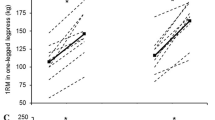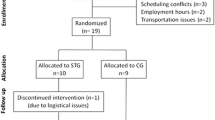Abstract
We investigated the effects of strength maintenance training on thigh muscle cross-sectional area (CSA), leg strength, determinants of cycling performance, and cycling performance. Well-trained cyclists completed either (1) usual endurance training supplemented with heavy strength training twice a week during a 12-week preparatory period followed by strength maintenance training once a week during the first 13 weeks of a competition period (E + S; n = 6 [♂ = 6]), or (2) usual endurance training during the whole intervention period (E; n = 6 [♂ = 5, ♀ = 1]). Following the preparatory period, E + S increased thigh muscle CSA and 1RM (p < 0.05), while no changes were observed in E. Both groups increased maximal oxygen consumption and mean power output in the 40-min all-out trial (p < 0.05). At 13 weeks into the competition period, E + S had preserved the increase in CSA and strength from the preparatory period. From the beginning of the preparatory period to 13 weeks into the competition period, E + S increased peak power output in the Wingate test, power output at 2 mmol l−1 [la−], maximal aerobic power output (W max), and mean power output in the 40-min all-out trial (p < 0.05). The relative improvements in the last two measurements were larger than in E (p < 0.05). For E, W max and power output at 2 mmol l−1 [la−] remained unchanged. In conclusion, in well-trained cyclists, strength maintenance training in a competition period preserved increases in thigh muscle CSA and leg strength attained in a preceding preparatory period and further improved cycling performance determinants and performance.





Similar content being viewed by others
References
Aagaard P, Simonsen EB, Andersen JL, Magnusson P, Dyhre-Poulsen P (2002) Increased rate of force development and neural drive of human skeletal muscle following resistance training. J Appl Physiol 93:1318–1326
Aagaard P, Bennekou M, Larsson B, Andersen JL, Olesen J, Crameri R, Magnusson PS, Kjaer M (2007) Resistance training leads to altered fiber type composition and enhanced long-term cycling performance in elite competitive cyclists [abstract]. Med Sci Sports Exerc 39:S448–S449
Andersen LL, Andersen JL, Magnusson SP, Suetta C, Madsen JL, Christensen LR, Aagaard P (2005) Changes in the human muscle force-velocity relationship in response to resistance training and subsequent detraining. J Appl Physiol 99:87–94
Atkinson G, Davison R, Jeukendrup A, Passfield L (2003) Science and cycling: current knowledge and future directions for research. J Sports Sci 21:767–787
Bastiaans JJ, van Diemen AB, Veneberg T, Jeukendrup AE (2001) The effects of replacing a portion of endurance training by explosive strength training on performance in trained cyclists. Eur J Appl Physiol 86:79–84
Beck TW, Housh TJ, Johnson GO, Coburn JW, Malek MH, Cramer JT (2007) Effects of a drink containing creatine, amino acids, and protein combined with ten weeks of resistance training on body composition, strength, and anaerobic performance. J Strength Cond Res 21:100–104
Behm DG, Sale DG (1993) Velocity specificity of resistance training. Sports Med 15:374–388
Bishop D, Jenkins DG, Mackinnon LT (1998) The relationship between plasma lactate parameters, Wpeak and 1-h cycling performance in women. Med Sci Sports Exerc 30:1270–1275
Bishop D, Jenkins DG, Mackinnon LT, McEniery M, Carey MF (1999) The effects of strength training on endurance performance and muscle characteristics. Med Sci Sports Exerc 31:886–891
Borg GA (1982) Psychophysical bases of perceived exertion. Med Sci Sports Exerc 14:377–381
Chi MM, Hintz CS, Coyle EF, Martin WH 3rd, Ivy JL, Nemeth PM, Holloszy JO, Lowry OH (1983) Effects of detraining on enzymes of energy metabolism in individual human muscle fibers. Am J Physiol 244:C276–C287
Coyle EF, Feltner ME, Kautz SA, Hamilton MT, Montain SJ, Baylor AM, Abraham LD, Petrek GW (1991) Physiological and biomechanical factors associated with elite endurance cycling performance. Med Sci Sports Exerc 23:93–107
Coyle EF, Sidossis LS, Horowitz JF, Beltz JD (1992) Cycling efficiency is related to the percentage of type I muscle fibers. Med Sci Sports Exerc 24:782–788
Cresswell AG, Ovendal AH (2002) Muscle activation and torque development during maximal unilateral and bilateral isokinetic knee extensions. J Sports Med Phys Fitness 42:19–25
Graves JE, Pollock ML, Leggett SH, Braith RW, Carpenter DM, Bishop LE (1988) Effect of reduced training frequency on muscular strength. Int J Sports Med 9:316–319
Hansen EA, Andersen JL, Nielsen JS, Sjøgaard G (2002) Muscle fibre type, efficiency, and mechanical optima affect freely chosen pedal rate during cycling. Acta Physiol Scand 176:185–194
Hausswirth C, Argentin S, Bieuzen F, Le Meur Y, Couturier A, Brisswalter J (2010) Endurance and strength training effects on physiological and muscular parameters during prolonged cycling. J Electromyogr Kinesiol 20:330–339
Hickson RC, Dvorak BA, Gorostiaga EM, Kurowski TT, Foster C (1988) Potential for strength and endurance training to amplify endurance performance. J Appl Physiol 65:2285–2290
Hopker J, Coleman D, Passfield L (2009) Changes in cycling efficiency during a competitive season. Med Sci Sports Exerc 41:912–919
Hug F, Dorel S (2009) Electromyographic analysis of pedaling: a review. J Electromyogr Kinesiol 19:182–198
Izquierdo M, Ibáñez J, Häkkinen K, Kraemer WJ, Ruesta M, Gorostiaga EM (2004) Maximal strength and power, muscle mass, endurance and serum hormones in weightlifters and road cyclists. J Sports Sci 22:465–478
Jeukendrup A, Saris WH, Brouns F, Kester AD (1996) A new validated endurance performance test. Med Sci Sports Exerc 28:266–270
Jeukendrup AE, Craig NP, Hawley JA (2000) The bioenergetics of world class cycling. J Sci Med Sport 3:414–433
Jones AM, Carter H (2000) The effect of endurance training on parameters of aerobic fitness. Sports Med 29:373–386
Joyner MJ, Coyle EF (2008) Endurance exercise performance: the physiology of champions. J Physiol 586:35–44
Kraemer WJ, Patton JF, Gordon SE, Harman EA, Deschenes MR, Reynolds K, Newton RU, Triplett NT, Dziados JE (1995) Compatibility of high-intensity strength and endurance training on hormonal and skeletal muscle adaptations. J Appl Physiol 78:976–989
Kraemer WJ, Koziris LP, Ratamess NA, Hakkinen K, Triplett-McBride NT, Fry AC, Gordon SE, Volek JS, French DN, Rubin MR, Gomez AL, Sharman MJ, Michael Lynch J, Izquierdo M, Newton RU, Fleck SJ (2002) Detraining produces minimal changes in physical performance and hormonal variables in recreationally strength-trained men. J Strength Cond Res 16:373–382
Loveless DJ, Weber CL, Haseler LJ, Schneider DA (2005) Maximal leg-strength training improves cycling economy in previously untrained men. Med Sci Sports Exerc 37:1231–1236
Lucía A, Pardo J, Durántez A, Hoyos J, Chicharro JL (1998) Physiological differences between professional and elite road cyclists. Int J Sports Med 19:342–348
Lucía A, Hoyos J, Pérez M, Santalla A, Chicharro JL (2002) Inverse relationship between VO2max and economy/efficiency in world-class cyclists. Med Sci Sports Exerc 34:2079–2084
Marcinik EJ, Potts J, Schlabach G, Will S, Dawson P, Hurley BF (1991) Effects of strength training on lactate threshold and endurance performance. Med Sci Sports Exerc 23:739–743
McCarthy JP, Agre JC, Graf BK, Pozniak MA, Vailas AC (1995) Compatibility of adaptive responses with combining strength and endurance training. Med Sci Sports Exerc 27:429–436
Mujika I, Padilla S (2000) Detraining: loss of training-induced physiological and performance adaptations. Part II: long term insufficient training stimulus. Sports Med 30:145–154
Narici MV, Roi GS, Landoni L, Minetti AE, Cerretelli P (1989) Changes in force, cross-sectional area and neural activation during strength training and detraining of the human quadriceps. Eur J Appl Physiol Occup Physiol 59:310–319
Østerås H, Helgerud J, Hoff J (2002) Maximal strength-training effects on force-velocity and force-power relationships explain increases in aerobic performance in humans. Eur J Appl Physiol 88:255–263
Paavolainen L, Hakkinen K, Hamalainen I, Nummela A, Rusko H (1999) Explosive-strength training improves 5-km running time by improving running economy and muscle power. J Appl Physiol 86:1527–1533
Pansarasa O, Rinaldi C, Parente V, Miotti D, Capodaglio P, Bottinelli R (2009) Resistance training of long duration modulates force and unloaded shortening velocity of single muscle fibres of young women. J Electromyogr Kinesiol 19:e290–e300
Pate RR, Macera CA, Bailey SP, Bartoli WP, Powell KE (1992) Physiological, anthropometric, and training correlates of running economy. Med Sci Sports Exerc 24:1128–1133
Rønnestad BR (2009) Acute effects of various whole body vibration frequencies on 1RM in trained and untrained subjects. J Strength Cond Res 23:2068–2072
Rønnestad BR, Hansen EA, Raastad T (2009) Strength training improves 5-min all-out performance following 185 min of cycling. Scand J Med Sci Sports. doi:10.1111/j.1600-0838.2009.01035.x [Epub ahead of print, cited Nov 9]
Rønnestad BR, Hansen EA, Raastad T (2010) Effect of heavy strength training on thigh muscle cross-sectional area, performance determinants, and performance in well-trained cyclists. Eur J Appl Physiol 108:965–975
Sassi A, Impellizzeri FM, Morelli A, Menaspà P, Rampinini E (2008) Seasonal changes in aerobic fitness indices in elite cyclists. Appl Physiol Nutr Metab 33:735–742
Schantz PG, Moritani T, Karlson E, Johansson E, Lundh A (1989) Maximal voluntary force of bilateral and unilateral leg extension. Acta Physiol Scand 136:185–192
Sunde A, Støren O, Bjerkaas M, Larsen MH, Hoff J, Helgerud J (2009) Maximal strength training improves cycling economy in competitive cyclists. J Strength Cond Res. doi:10.1519/JSC.0b013e3181aeb16a [Epub ahead of print, cited Oct 22]
White JA, Quinn G, Al-Dawalibi M, Mulhall J (1982) Seasonal changes in cyclists’ performance. Part I. The British Olympic road race squad. Br J Sports Med 16:4–12
Acknowledgments
The authors express their thanks to the participants for their time and effort. No founding was received for this work.
Conflict of interest
The authors declare that they have no conflict of interest.
Author information
Authors and Affiliations
Corresponding author
Additional information
Communicated by William Kraemer.
Rights and permissions
About this article
Cite this article
Rønnestad, B.R., Hansen, E.A. & Raastad, T. In-season strength maintenance training increases well-trained cyclists’ performance. Eur J Appl Physiol 110, 1269–1282 (2010). https://doi.org/10.1007/s00421-010-1622-4
Accepted:
Published:
Issue Date:
DOI: https://doi.org/10.1007/s00421-010-1622-4




